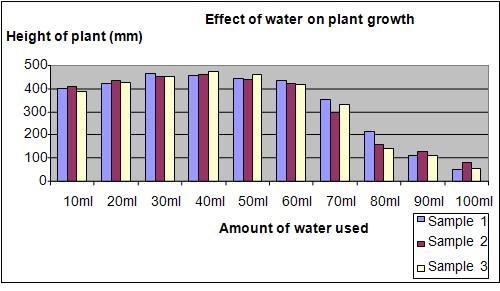| Complexity level: | 4 |
| Project cost ($): | 20 |
| Time required: | Preparation will take approximately one day, while observation and recording of data will require ten days |
| Material availability: | Easily found |
| Safety concerns: | Basic safety requirements |
Hypothesis
Plants require sufficient water for a healthy growth rate, but over--watering plants will result in slower growth
Overview
Water and plant growth
The amount of water required by a plant depends on the type of soil used, the size of the pot, the species of the plant and the age of the plant. The type and condition of soil determines its water retention properties . Soil that has good water retention properties will require less frequent watering. The size of the pot determines the amount of water that can be added to the soil in order to maintain a reasonable level of moisture.
The size of the leaves and stem of the plant determines the amount of water that the plant needs. The age of a plant is also important, as younger plants tend to require more frequent watering to maintain the moisture on the soil surface since their roots have not grown deep enough. On the other hand, older plants can be watered with more water and less frequently because their roots would usually have grown deep into the soil.
Scientific Terms
Materials
Materials required for the experiment:
- 1 packet of radish seeds
- 10 small plastic pots
- Soil to fill the 10 pots
- Tap water
- 1 measuring cylinder
- 1 ruler (1 meter)
- 1 marker
Procedure
1. The independent variable in this experiment is the amount of water poured into the pot everyday. The dependent variable is the growth of the radish plant, which is determined by measuring the height of the plants in each group. The constants (control variables) are the environment that the plants are kept in (temperature, humidity, light, etc), the species of plant used, the size of the pot and the type of soil.
2. Fill the ten pots with the same amount of soil, and place approximately three radish seeds in each pot. (More than three radish seeds can be placed in each pot to act as backup in case some seeds do not germinate. Remove any unwanted plants once germination has occurred)
3. Using the marker, label the pots as 10 ml, 20 ml, 30 ml, 40 ml, 50 ml, 60 ml, 70 ml, 80 ml, 90 ml and 100 ml.
4. The marking on the pots indicate the amount of water that will be given to the plants every day. Use the measuring cylinder to measure the amount of water before pouring it into the pot, and water the plants twice a day, once in the morning and once in the evening. For example, water the pot marked 10 ml with 10 ml of water in the morning, and another 10 ml of water in the evening. Repeat the procedure for ten days.
5. Measure the height of the plants on the 10th day and record the data in the table given below.

Results
The optimum amount of water required for optimum radish plant growth was observed to be between 30 ml to 50 ml (watered twice a day). When the radish plants were watered with more than 60ml of water, slower plant growth was observed.
| Plant sample | Height of radish plant after 10 days of watering with different amounts of water (mm) | |||||||||
| 10ml | 20ml | 30ml | 40ml | 50ml | 60ml | 70ml | 80ml | 90ml | 100ml | |
| 1 | 398 | 420 | 465 | 455 | 445 | 431 | 352 | 214 | 115 | 52 |
| 2 | 410 | 435 | 452 | 463 | 436 | 422 | 298 | 156 | 129 | 76 |
| 3 | 385 | 425 | 448 | 471 | 458 | 415 | 330 | 138 | 111 | 55 |
Use the graph below to plot the experimental data recorded in the table above.

Conclusion
The experimental data and analyzed results support the hypothesis that plants require a sufficient amount of water, but over-watering plants will result in slower growth.
All plants need water to grow, and any deprivation of water will eventually lead to its death. However, providing plants with too much water can also be detrimental. If the soil is always wet and the roots are constantly covered with water, the plant will not receive enough oxygen, which will cause the roots to rot and kill the plant. Plants need both oxygen and water to grow. The type and quantity of soil used will also affect the amount of water required by the plant.
The best time to water plants is in the mornings and afternoons, when it's warmer. This helps prevent them from wilting due to heat. Although it is quite difficult to determine the optimum amount of water that a plant requires, the easiest and most commonly used method is to touch the soil to see if it is still moist.
Also consider
What would happen if the science fair project were to be repeated using different types of plants such as mung beans or chinese bamboo?
This experiment can be repeated by placing the plants in different environments such as under the sun, in a shaded area or indoors.
References
How to water plants - http://home.howstuffworks.com/how-to-water-plants.htm
How to water a plant – how much water should I give my plant - http://www.gardeningknowhow.com/indoor/how-to-water-a-plant.htm

